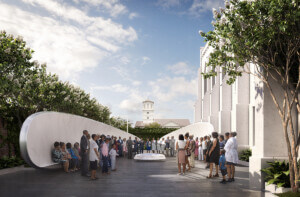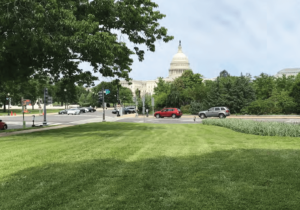On Thursday, June 3, at 4 a.m., crews from the Minneapolis Department of Public works showed up at 38th Street and Chicago Avenue, now known colloquially as George Floyd Square, to remove the protest art and gardens around the globally recognized raised fist monument near where George Floyd was killed almost exactly a year before. Over the last year, Minneapolis has used similar surprise tactics in shutting down the many homeless encampments in city parks that emerged as COVID respites from crowded shelters.
When the city trucks showed up at George Floyd Square that morning, it was tweets and Instagram–and probably a lot of panicked phone calls–that caused hundreds of people to rush over there to protect this space of protest and memory. They hastily erected new traffic barricades from whatever materials they could find, including couches, palettes, and leftover building materials.
Thursday’s stealthy clean sweep activated a policy announced several days earlier by Mayor Jacob Frey. Citing complaints from “neighbors trapped in their homes,” business owners with diminished access, spikes in crime, and “traffic flow,” Frey insisted that reopening the intersection was essential for the city. He argued that now is the time to “reconnect” the city with a commitment to equity citywide and investment in the neighborhood.
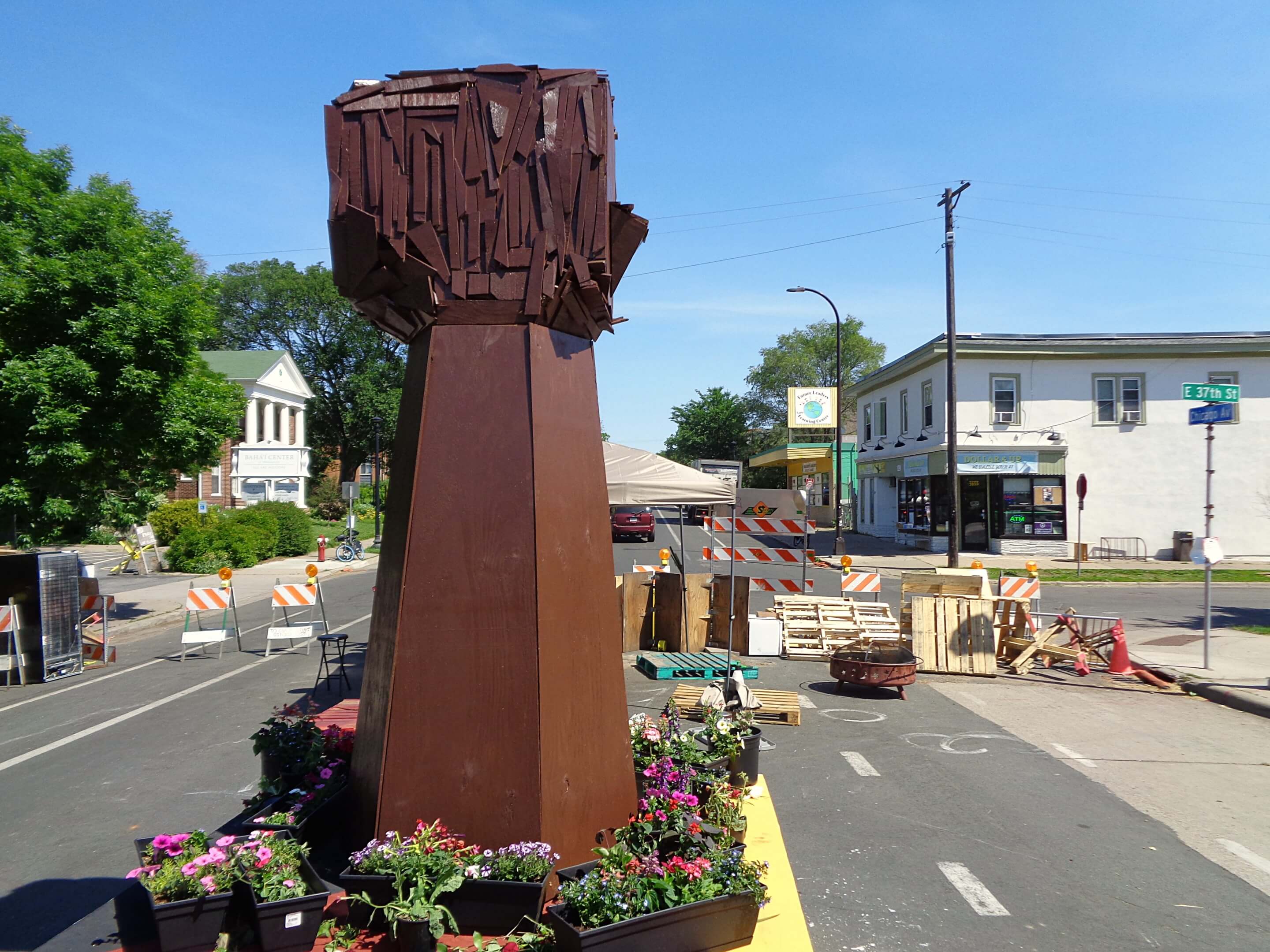
The problem for the hundreds of “caretakers” and allies, who have stewarded the square as an “autonomous zone” over the last year, is that George Floyd Square is already open—perhaps for the first time ever in a city with a history of systemic racism. As the City withdrew due to pushback, they immediately started to replant gardens on the sidewalks and around the Raised Fist statue in the intersection.
Thursday’s Press Conference: Justifying the Demolition
That afternoon, City of Minneapolis spokeswoman Sarah McKenzie told The Washington Post that city leaders were working “with a community group on the transition of the memorial. The Agape Movement, a peacekeeping organization whose staff includes ex-gang members, is working with the city to help keep the memorials intact….”
She further described the day’s events as part of a “community-led reconnection process with the City supporting efforts to reopen the intersection while preserving artworks and memorials to George Floyd.”
Around 12:15 p.m., Mayor Frey and two city council members from neighboring wards held a news conference to explain the city’s morning action. They repeated key messages such as: “many conversations,” “partnerships,” “a lot more work to do,” and not surprisingly, “the process of healing.”
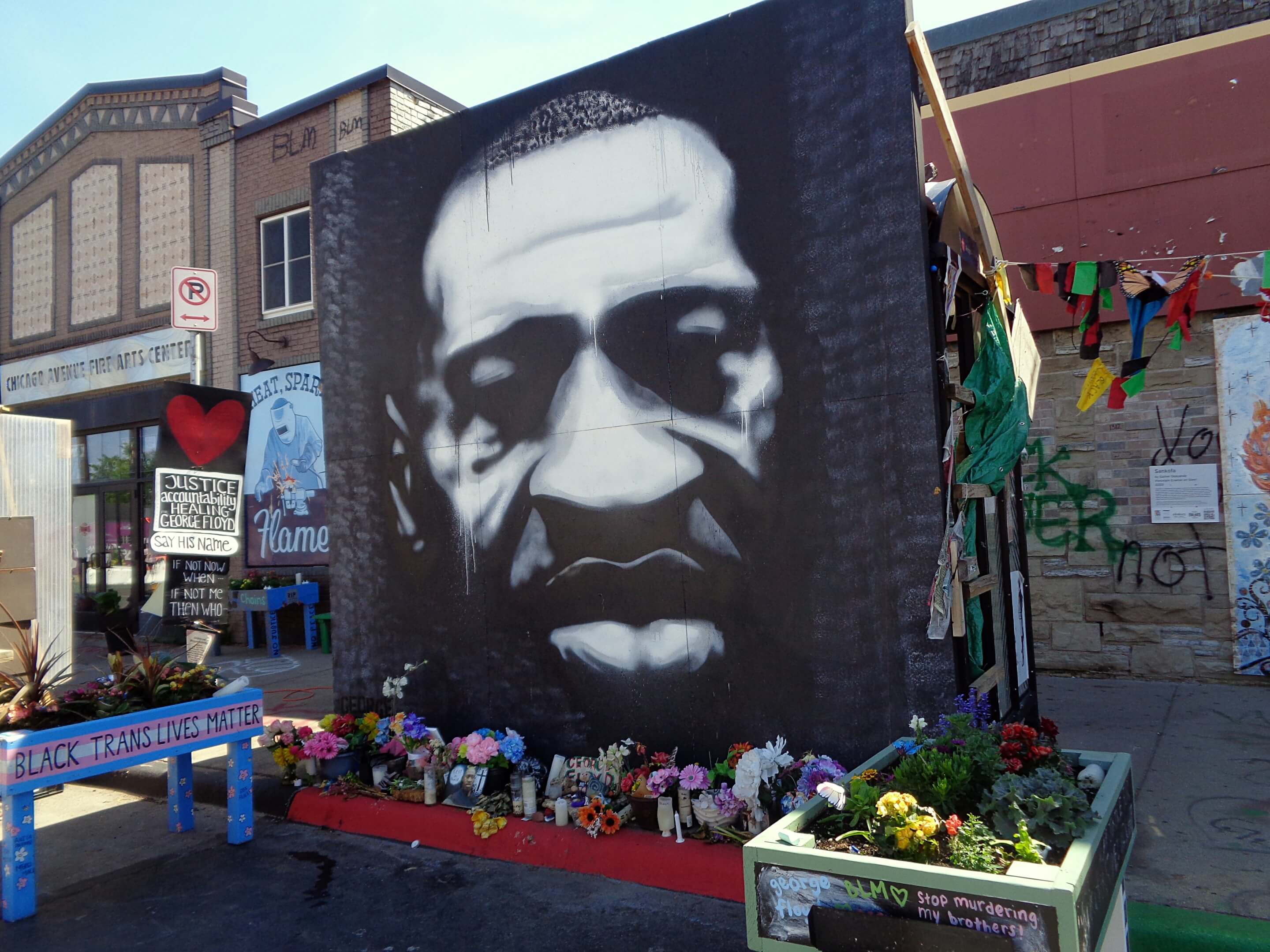
Mayor Frey repeatedly used the phrase “phased reconnection” to describe a three-year plan to “open up” the street, support local business, and spur investment at the square. He cited extensive video dialogues, online surveys, and community involvement to craft both this strategy and the 38th Street THRIVE vision plan—already underway when Floyd was killed. The city’s core message was that none of these benefits and rebirth could happen until traffic flow was restored.
Saturday, June 5th
Two days later, that Saturday set a new temperature record for the date, reaching 99 degrees F. and exacerbated by the city’s heat island effects. After a year of avoiding the 38th and Chicago intersection for fear of being part of the wave of photo tourism, I realized that now was the time to visit. My motive was the Mayor’s removal of street-blocking features.
Visiting the square in person is a completely different experience from seeing it in pictures or streaming video. I was immediately struck by how quiet it was, how calm people were, how much cooler these reclaimed streets seemed compared with the rest of the city on this hot morning, in part because so much of Minneapolis is engineered with wide streets for traffic flow. Although rich with colorful handmade murals, gardens, and street painting, the space of the intersection is defined in an almost Baroque and formal way. In all four cardinal directions, the “gateways” set two blocks from the intersection are marked by raised fist sculptures that are nearly identical to—but smaller than the monument in the middle of the square.

Resembling the shape of obelisks, all of them were built last summer as wood structures. When vandals attempted to set fire to the main monument, the artist clad all five with Cor-Ten steel, heightening their sense of permanence and architectural tone.
A Proxy for the City
In interviews and presentations, city leaders repeatedly stated that local citizens of color have been leading the management, security, and planning for George Floyd Square. Last summer, they contracted with The Agape Movement—for “Case Management Services”. While the details of how much Agape has been paid to date are unclear, this organization has been in charge of security and serving as liaison between the square’s caretakers and the city.
Yet, when Agape’s team showed up on Thursday morning to clear the way for city crews, many caretakers and volunteers questioned the group’s real purpose. The next day, the Minneapolis Spokesman-Recorder noted that The Agape Movement was “seemingly running interference for the City….”.
For months, the mainstream media has confusingly reported Agape’s role, leaving the impression that they were a gang hired for security, or they were acting as peacemakers, or they were outside contractors, or that everything they did represented the wishes of the community. Thursday’s dawn raid revealed that Agape was really working for the city, serving as a kind of buffer allowing the police to stay away and supposedly making a bridge to city government.
In the press conference aftermath, city leaders insisted that Agape was working for neither the mayor nor the police. Frey praised the “on the ground leadership in Agape” while implying that it was Agape who chose the timing and tactics for the dawn confrontation. By then it was becoming clear that the city was trying to avoid blame for any mishaps by positioning Agape as the voice of the people and decision-maker.
Frey and the two council members also released the statement: “The Agape Movement brought together community leadership to begin facilitating the phased reconnection this morning, with the City playing a supportive role. We are grateful for the partnership.”
KSTP news followed the city’s line on Agape by noting that this “group that led the removal of barricades around George Floyd Square early Thursday morning is acting as a buffer between the City and the community through a paid partnership. The Agape Movement’s mission is to ‘bridge the gap between the community and law enforcement.’”
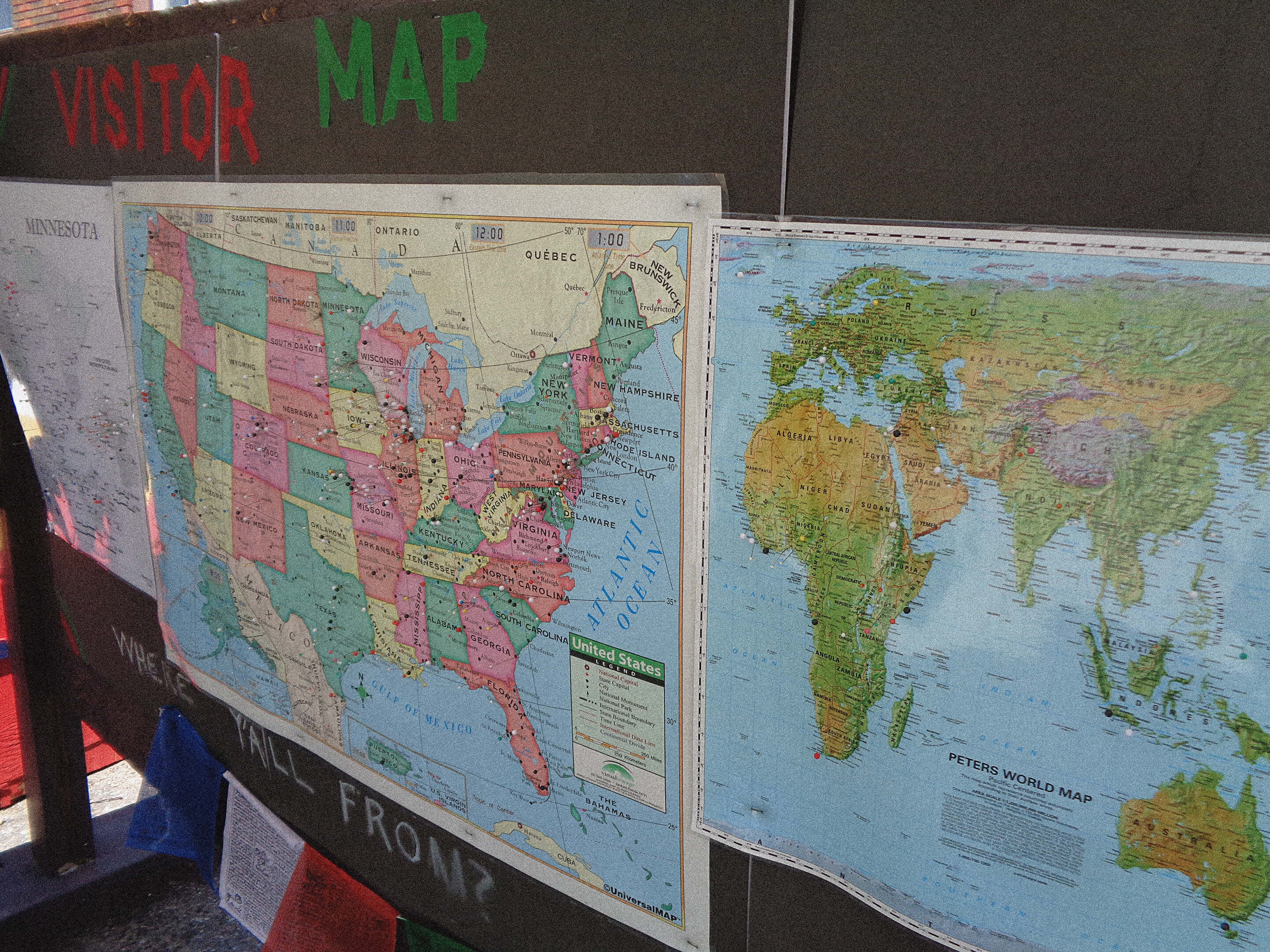
In a rare challenge to such official accounts, the Spokesman-Recorder wrote that some of Thursday’s pushback was “precipitated by accusations that the City of Minneapolis, particularly Mayor Jacob Frey and Councilmembers […] appeared to make Agape a scapegoat of sorts and seemingly used the organization to hide their intent to reopen the intersection”. A few other news outlets covered the caretakers’ perspective.
On April 20, 2021, when Derek Chauvin, the police lieutenant who murdered George Floyd, was convicted on all three counts for which he was charged, hundreds of people flocked to the square again to follow the news and to celebrate once the verdicts came in.
Today, there are stirrings of talk that the square itself at the intersection should become a National Historic Monument and that the surrounding blocks should be designated as a National Historic Landmark District. There is no question that the Floyd murder and its ongoing effects are the most historic moment in Minnesota’s history since the Euro-American conquest of the 19th century. Something like these designations should happen, but the stewardship of the area has to be something unprecedented in American historic preservation.
We also need an unprecedented design solution and plan for limited vehicular access (as often seen at landmark sites) that preserves the viability of this singular space. A new Bus Rapid Transit line under construction along Chicago should continue through the square. Emergency and service vehicles also need access. Local businesses need some kind of drop-off and nearby parking to thrive. Jay Webb, the square’s gardener foresaw this need for balance when he scaled the monument garden to allow 24-feet lanes for vehicles of all types to make turns.
A year ago, I wrote a story on George Floyd focusing on the hundreds of protest murals that were being created across the Twin Cities. I was struck by how the museum and historic preservation communities had no idea of what to do with them, who should save them, or that it was their political meaning and memory—and not their physicality— that mattered. This bias reflects over a century of American historic framing of events through monuments and architecture dating to Mt. Vernon.
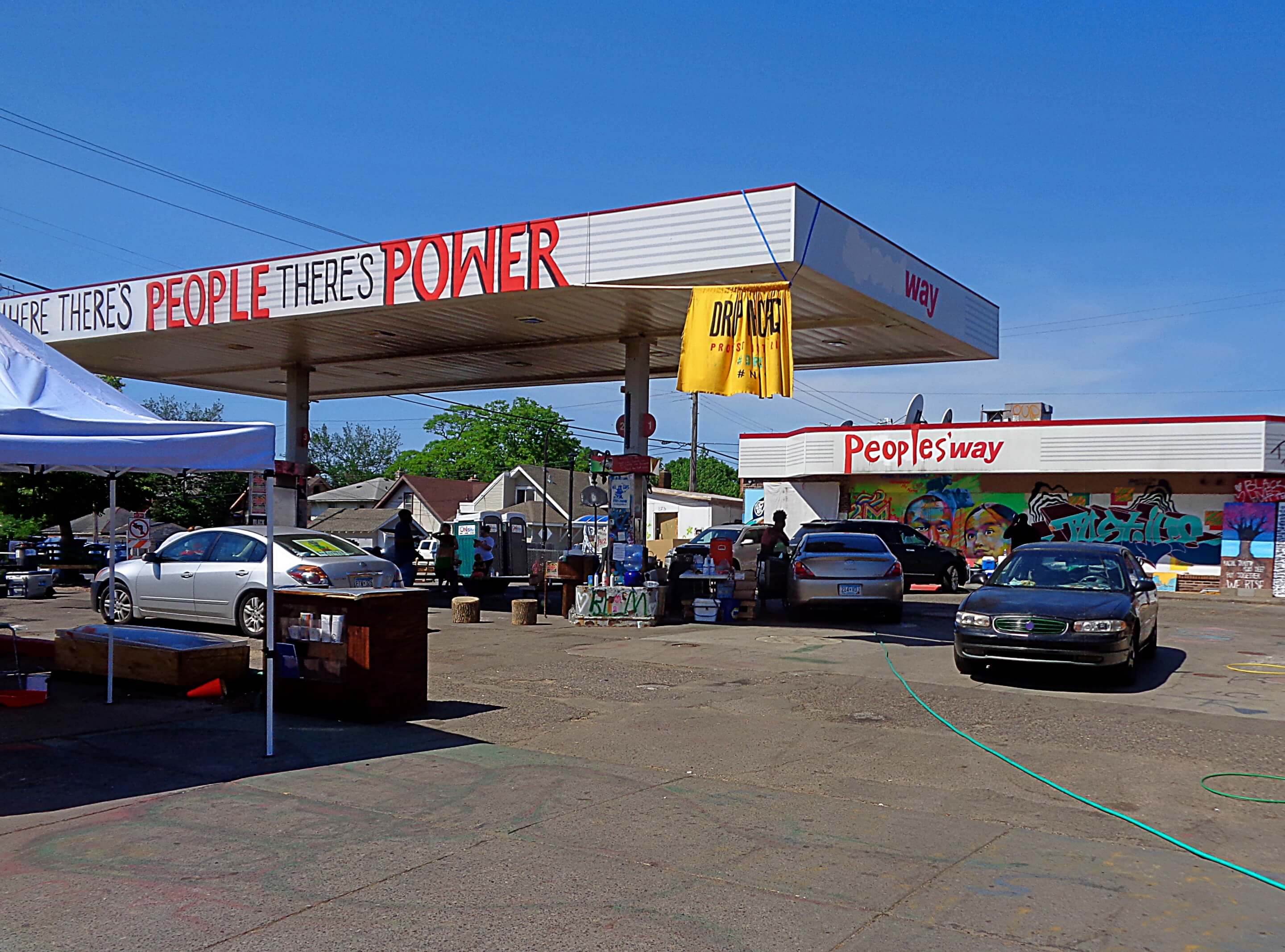
Today we have an intersection that many people hope to set aside for gathering. The city of Minneapolis wants to tear down its barriers for traffic while physically enclosing the actual site where Floyd died, the gardens, and artworks with new barriers. The argument is that such barriers are essential to protect the memorials from traffic.
But when visiting, it’s obvious that the new low-rise walls set these human works of memory apart on podiums like objects in a museum. The true meaning of these expressions comes from being part of a tended place and not encased as works of art.
Tuesday, June 8th
After Agape and city crews returned early Tuesday morning to reopen the drive lanes, I came back to the square to see if it was open to vehicles. At noon, a few cars were passing through after negotiating some parked cars and construction signs. I could sense that something was now different from my Saturday visit. The caretakers and visitors were still there. But the streets were open as if some temporary hiatus had occurred. But, when one car paused and its driver took pictures, one of the caretakers quickly put a stop to it. Visitors can take many pictures, but only when engaging with the space.
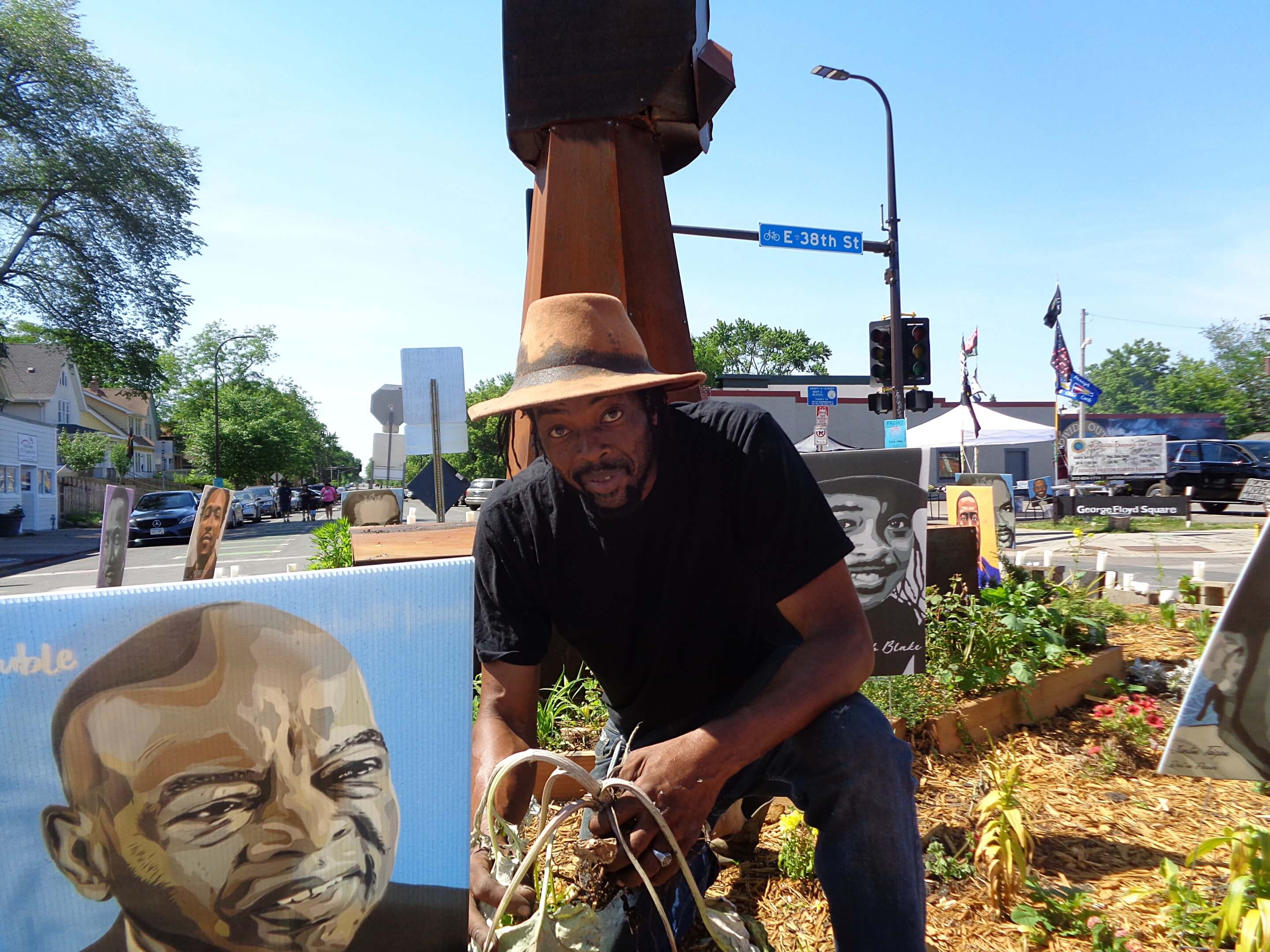
I talked for the second time with Jay Webb, who goes by the name “The Gardener” if you ask him. A year ago, he was one of the first people to proclaim the square a sanctuary space even as the riots and fires were still raging across the Twin Cities. He told me that of all the “insurrectionists” who were on the streets those nights, no one who came to George Floyd Square was arrested.
Part of the reason Americans keep building walls is that we consider them as tools to keep something out, to protect us from harm, unwanted immigrants, or criminals. But there is an older sense of boundaries dating to the pre-Socratics that values physical enclosure to bring something forth from within—the local spirit of a sacred spring, the greens, herbs and medicinal plants that grow in a cloister garden, a sanctuary of memory with a different flow of space and time.
Jay the gardener told me that his work was far more than horticulture. He said, “you know who I consider my real plants?” Then, he swept his arm over everyone there and up Chicago Avenue, “it’s all of you.”








